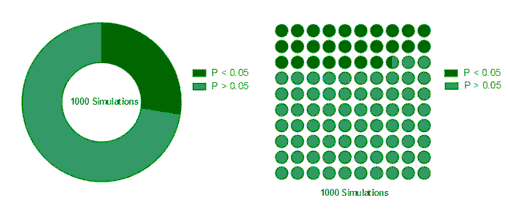

Fisher's test is rarely calculated by hand and can be very intensive even for a computer. Several methods exist to calculate Fisher's test, and this calculator uses the summing small P values method. If you want to enter observed and expected values for each category (or your analysis is not exactly four categories in a 2x2 contingency table) you need this chi-square calculator instead. Two-tailed is more common for contingency tables. Then select either a one-tailed or two-tailed test. For large samples its effect is negligible. Yates is sometimes appropriate to keep from overestimating the relationship. It makes the approximation more conservative but is not commonly used. Yates' continuity correction can be used alongside chi-square. It's called an exact test, but that can be misleading because it's only exact if your experiment meets that condition. It was created for a specific (and rare) experimental design where marginal totals are fixed. This is also known as the chi-square test of independence.įisher's exact test is used to calculate P values for small sample sizes. It provides an approximate P value and can be calculated by hand as well. We provide three ways to compute a P value from a contingency table:Ĭhi-square is the standard method and is best when you have a large number of subjects in categories. The typical statistical test for contingency tables evaluates if there is an association between the variables. Label your groups and outcomes, then enter the actual number of subjects in each category (whole numbers only, not percentages or decimals).
#Graphpad prism 6 grouped graph inputting 2x2 design how to
How to use the contingency table calculatorĮnter your data into the contingency table calculator. Be careful with interpretation, though, as a relationship does not necessarily imply causation! The goal is to determine if the factors are associated, for example, a subject in group 1 may be more likely to be part of the outcome 2 category.

Each subject falls into one of the two levels for each factor, which results in four possible categories in all. A 2x2 table means that subjects are separated based on two factors (or questions) with two levels in each factor (groups 1 or 2 for the first factor and outcome 1 or 2 for the second factor). Unlike regression analysis or ANOVA, both of the factors are categorical (rather than numeric variables). An example is comparing subjects with and without some risk factor (such as smoking/non-smoking) and further categorizing by whether they have a disease (such as lung cancer). Contingency tables are used to analyze count data across two or more experimental factors by separating the subjects into the appropriate categories.


 0 kommentar(er)
0 kommentar(er)
